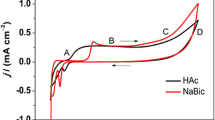Abstract
We investigated the penetration depth profiles of lithium ions in titanium oxide thin film during electrochromic reactions. The penetration depth profiles were obtained using time-of-flight secondary ion mass spectrometry (TOF-SIMS) for various states associated with coloring and bleaching reactions.
It was found that the amount of penetrated lithium ions in the coloring process decreased sharply with increasing depth for samples in which lithium ions were inserted by applying a voltage, Vi, for 50 s in electrolyte. Over 70 % of the total lithium ions were detected within 10 nm from the surface of the film. The amount of ions in each depth was represented as a function of 1/d 2 (d, depth), and the penetration depth of the lithium ions increased by increasing Vi. Furthermore, we found that the de-intercalation of the lithium ions by applying a reverse voltage arise preferentially near the surface of the film. The de-intercalated (released) lithium ion ratio seems to decrease with increasing the penetration depth.
Hence, we expected that an electrochromic device using nanorod-structured titanium oxide film would improve reproducibility owing to a small number of unreleased ions. A film composed of nanorods was made by oblique evaporation. The electrochromic device using the nanorod-structured film showed excellent reproducibility for small value of driving voltage. The number of possible switching increased by a factor of 30 according to the driving voltage.
In this paper, we discuss the details of the relationship between the lithium ion penetration depth profile and the electrochromic reactions.






Similar content being viewed by others
References
Zhang J, Tu J, Xia X, Qiao Y, Lu Y (2009) Sol Energy Mater Sol Cells 93:1840–1845
Yamazaki J, Kuranaga T, Takaba H, Saito N, Inoue Y, Takai O (2006) J Surf Finish Soc Jpn 57:459–460
Passerini S, Scarminio J, Scrosati B, Zane D, Decker F (1993) J Appl Electrochem 23:1187–1195
Michalak F, Rottkay K, Richardson T, Sslack J, Rubin M (1999) Electrochim Acta 44:3085–3092
Kang S, Lim J, Kim H, Kim J, Chung Y, Sung Y (2009) Chem Mater 21:2777–2788
Kitao M, Oshima Y, Urabe K (1997) Jpn J Appl Phys 36:4423–4426
Lee K (2008) J Korean Phys Soc 52:1070–1076
Wang C, Lin S, Chen Y (2008) J Phys Chem Solids 69:451–455
Yoshimura K, Miki T, Tanemura S (1997) J Vac Sci Technol A 15:2673–2676
Yonghong Y, Jiayu Z, Peifu G, Xu L, Jinfa T (1997) Thin Solid Films 298:197–199
Ozer N (1992) Thin Solid Films 214:17–24
Tomoyoshi M, Taga Y (1989) Appl Opt 28:2466–2482
Mbise G, Bellac D, Niklasson G, Granqvist C (1997) J Phys D:Appl Phys 30:2103–2122
Colgan MJ, Djurfors B, Ivey DG, Brett MJ (2004) Thin. Solid Films 466:92–96
Flaherty DW, Dohnalek Z, Dohnalkova A, Arey BW, McCready DE, Ponnusamy N, Mullins CB, Kay BD (2007) J Phys Chem C 111:4765–4773
Flaherty DW, Hahn NT, May RA, Berglund SP, Lin Y-M, Stevenson KJ, Dohnalek Z, Kay BD, Mullins CB (2012) Acc. Chem Res 45:434–443
Berger S, Ghicov A, Nah Y, Schmuki P (2009) Langmuir 25:4841–4844
Lee S, Deshpande R, Parilla P, Jones K, To B, Mahan A, Dillon A (2006) Adv Mater 18:763–766
Ghicov A, Albu S, Macak J, Schmuki P (2008) Small 4:1063–1066
Sodergren S, Siegbahn H, Rensmo H, Lindstrom H, Hagfeldt A, Lindquist S (1997) J Phys Chem B 101:3087–3090
Krings L, Tamminga Y, Berkum J, Labohm F, Veen A, Arnoldbik W (1999) J Vac Sci Technol A 17:198–205
Decker F, Donsanti F, Salvi A, Ibris N, Castle J, Martin F, Alamarguy D, Vuk A, Orel B, Lourenco A (2008) J Braz Chem Soc 19:667–671
Monk P, Mortimer R, Rosseinsky D (2007) Electrochromism and electrochromic devices, Chapter 3 and Chapter 5
Acknowledgments
We are grateful to our colleagues from Canon Inc.: Amita Goyal and Alexis Debray for reading the manuscript and making useful suggestions.
Author information
Authors and Affiliations
Corresponding authors
Electronic supplementary material
Below is the link to the electronic supplementary material.
ESM 1
(DOCX 55.5 kb)
Rights and permissions
About this article
Cite this article
Ueda, M., Tsukamoto, M., Sakai, A. et al. Lithium ion penetration depth profiles and reversibility of electrochromic reaction for TiO2 thin films. J Solid State Electrochem 18, 2637–2645 (2014). https://doi.org/10.1007/s10008-014-2520-1
Received:
Accepted:
Published:
Issue Date:
DOI: https://doi.org/10.1007/s10008-014-2520-1




